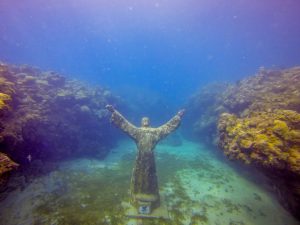By Kelly Oden
Scuba divers and art lovers rejoice! The Cultural Arts Alliance of Walton County (CAA) in partnership with the South Walton Artificial Reef Association (SWARA) and support from the National Endowment for the Arts will join two of South Walton, Florida’s most beloved attractions—the arts and the Gulf of Mexico—with the introduction of The Underwater Museum of Art (UMA), North America’s first underwater permanent sculpture exhibit. The UMA is the first presentation of the CAA’s Art In Public Spaces Program and will augment SWARA’s mission of creating marine habitat and expanding fishery populations while providing enhanced creative, cultural, economic and educational opportunities for the benefit, education and enjoyment of residents, students and visitors in South Walton.
The museum will be the first curated underwater museum in North America, says Allison Wickey, 30A local artist and Cultural Arts Alliance Board Member. “There are other sculptures and monuments dropped in our oceans and gulf but this is the first curated underwater museum of art in North America. There are other underwater sculpture parks located in Granada, Spain, London and other parts of the world.”
Currently, Gulf coastal waters off Walton County are 95 percent barren sand flats. “The sand flats are beautiful because of our white sands, but they provide nothing for organisms to grow on, nor shade for fish to gather or hide, ”says Wickey. “The reefs will provide a surface for microorganisms to cling to at the same time providing food and shelter for small marine life which will draw in bigger marine life.”
The first phase of the UMA will include up to six pieces of sculpture, which will be deployed in the spring of 2018 on a one-acre patch of seabed off Grayton Beach State Park, which has been dedicated to the CAA for the purpose of a permanent underwater sculpture exhibit. The UMA will be deployed with SWARA’s existing USACOA and FDEP permitted artificial reef project that includes nine nearshore reefs located within one nautical mile of the shore in approximately 50-60 feet of water.
The museum will accessible to scuba divers and the CAA hopes to install a full-time sculpture cam so the public can see the growth and the sea life that will be drawn to the museum.
The CAA is calling for local, national and international artists to submit work for consideration for the first installment and permanent exhibition. The artwork must be made from concrete, limestone, aluminum, or stainless steel. “These materials are used because they provide a hard, clean surface that instigates natural marine growth and they do not pollute the water as they slowly biodegrade,” says Wickey.
Sculptures must be created above ground and delivered directly to the deployment area where each will be attached to a grouper box/reef. The sculptures will then be transported by ship to the gulf and carefully sunk to the floor where they will become a base to which an artificial reef will form, attracting marine life and divers. Applications will be accepted through August 11, 2017 and artwork must be received no later than September 15, 2017. Additionally, the NEA grant is a matching grant and the CAA is still seeking funds for this project. If you are interested in supporting this project or if you are an artist interested in submitting a sculpture, visit www.CulturalArtsAlliance.comfor more information.

